.
CET Talks: Accreditation, Learning and Leadership
Episode 13
FEBRUARY 15 2024 . 26 MINUTES

Instructional Design on a Shoestring
Tune in as Randy Bowman, President and CEO of IACET, and co-host, Mike Veny, CEO of Mike Veny, Inc., an IACET Accredited Provider, speak with Brian Washburn, author of the new book “Instructional Design on a Shoestring.” Brian outlines his approach to applying the ADDIE model and Build-Borrow-Buy methodology to instructional design projects with limited resources. He shares quick tips, shortcuts, and case studies on how to develop quality training events even when budgets are tight. The discussion covers strategies and best practices for overcoming common challenges instructional designers face due to constraints on capital and time. Brian also provides advice for new designers feeling overwhelmed by restrictions and offers his vision for the future of the field.
Listen to the Podcast
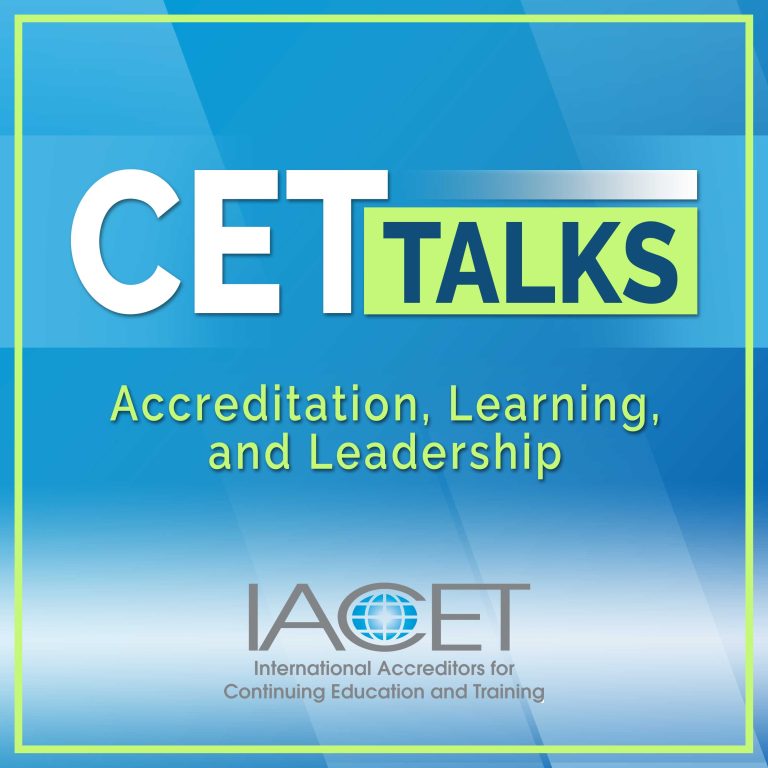
Welcome to CET Talks, the International Accreditors for Continuing Education and Training’s podcast, where we convene thought leaders in the continuing education and training ecosystem to share ideas, research, best practices, and experiences that promote the creation of a world that learns better. Your hosts are Randy Bowman, Interim President and CEO of IACET, and certified corporate wellness specialist Mike Veny.
Tune in as Randy Bowman, President and CEO of IACET, and co-host, Mike Veny, CEO of Mike Veny, Inc., an IACET Accredited Provider, speak with Brian Washburn, author of the new book “Instructional Design on a Shoestring.” Brian outlines his approach to applying the ADDIE model and Build-Borrow-Buy methodology to instructional design projects with limited resources. He shares quick tips, shortcuts, and case studies on how to develop quality training events even when budgets are tight. The discussion covers strategies and best practices for overcoming common challenges instructional designers face due to constraints on capital and time. Brian also provides advice for new designers feeling overwhelmed by restrictions and offers his vision for the future of the field.
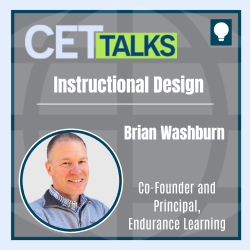
Transcription
Host: Welcome to CET talks, the International Accreditors for Continuing Education and Trainings podcast, where we convene thought leaders in the continuing education and training ecosystem to share ideas, research, best practices, and experiences that promote the creation of a world that learns better. Enjoy the episode.
Randy Bowman: Hello, and welcome to CET talks. My name is Randy Bowman, and I am here with my co-host, Mike Veny, a certified corporate wellness specialist, and CEO of an IACET-accredited provider. How are you doing today, Mike?
Mike Veny: I am good. And to everyone out there, I am CET Co-host Mike Veny. Randy, I have a question for you. I learned somewhere that you were a software developer.
Randy Bowman: Oh, yes. Software developer, turned IT executive, turned CEO. But at my root, I like to solve problems with software.
Mike Veny: Okay. In software development, that’s expensive and complicated, right?
Randy Bowman: Oh, sure. There’s an old adage whenever you’re developing software, you can have it good, you can have it cheap, or you can have it fast. Pick two. It really quantifies the tension to manage the different resources of time, money, availability, and speed of getting something out there. One of the things I’ve learned is that almost all design projects, whether it’s software or instructional design, face these exact same tensions. That’s why I’m so excited to have with us today, Brian Washburn. He is the author of Instructional Design on a Shoestring. Besides being an author, he’s the co-founder and CEO of Endurance Learning, a boutique instructional design firm that’s crafting innovative instructor-led and e-learning programs for a diverse client base, all the way from small non-profits to Fortune 500 companies. He has 25 years of experience, starting as a Peace Corps volunteer in Paraguay as a nonprofit sector leader. He’s a recognized industry expert, having been acknowledged as the top young trainer by Training Magazine. He has served as the president of ATD Puget Sound and has an active online presence. He has his own podcast, which maybe we’ll hear about, as well as his “Train Like a Champion” blog and engages with the community on Twitter at Flipchartguy. Brian, thank you so much for joining us. We’re excited to have you here. Tell us what inspired you to write this book, Instructional Design on a Shoestring.
Brian Washburn: Thank you so much for having me. First of all, I really appreciate the opportunity, and I’m really excited to talk with both of you today. When it comes to Instructional Design on a Shoestring, it was really interesting listening to your little banter before you started. You talked about software development, and you can have three options. You get to choose two, so it can be good, fast, or cheap; those are your three options. A lot of times with training, it is the same way. Oftentimes cheap is one of the options that a lot of people choose. I’ve worked in nonprofits, I’ve worked for NGOs, and the limited resources that we have to work with is typically a fact of life, and it’s also an effective life. I feel a lot of other organizations, even if they’re large organizations that are well-funded, don’t want to spend money on an activity that doesn’t often directly generate revenue. A lot of times training organizations are seen as cost centers. Why are we going to spend money here when we can spend money on marketing or other things that typically help us bring in money? I’m not saying that’s right or wrong; actually, I’m saying it’s wrong, but when it comes to instructional design on a shoestring, it’s a fact of life for a lot of people who design training. That was one of the really big drivers behind what this book is about.
Mike Veny: Well, IACET, the International Accreditors for Continuing Education and Training, is all about adhering to the standard that we have. We’re all about training of the highest quality, I should say, and let me just tell you who’s listening to this podcast. We have accredited training providers and those who are aspiring. I remember when I was bringing my organization on that journey, I had learned about instructional design and saw how expensive it was. My question for you is, how do you bootstrap without sacrificing quality?
Brian Washburn: For me, a lot of times when I think of quality, I think of the process first. Doing an appropriate needs assessment and seeing what’s truly going on, and then crafting sound learning objectives; that’s when we can get into creativity, which needs to make up for scarce money, time, or people. When it comes to how this book might be helpful for addressing some of those bootstrapping challenges, I see this book as a thought partner for people who are looking to put together training programs or an instructional design project on limited resources; “on a shoestring” is in the title of the book. So questions like, “Is informal learning really going to be the answer? Do we actually need to create training in order to solve this challenge?” If informal learning’s going to help you, then this book offers 23 different ideas for informal learning. Is instructor-led training going to be the answer or e-learning? If that’s the case, there are lesson plans and storyboard templates. You need help sparking your creativity; there’s half a dozen ideas in there for places to find inspiration. There’s lots of different thoughts and ideas based on what your needs are. If you’re looking for a quality way to address a problem or challenge through learning in your organization, I see this book as an inanimate thought partner to help people navigate some of those challenges.
Mike Veny: I love that term “thought partner” because it’s a very overwhelming process when you’re first getting into this instructional design thing. I want to talk about the ADDIE model. Before I go into that, when I started on my company’s accreditation journey, I didn’t know what the ADDIE model was. For anyone out there who might be listening, can you explain what that is and how you’ve adapted it for instructional designers working with tight budgets or resource constraints?
Brian Washburn: That’s a great question. For anybody who’s listening who is like, “Ooh, I have to put together training. What is ADDIE?”, it’s a good thing for people to get to know and be familiar with, especially if you’re developing training. ADDIE is an acronym for a model that has five components to it. That first A is analyze. What’s happening in this situation? Then the first D is design. What are you going to create in order to address the challenge or issue that you’re uncovering through the analysis? The second D in ADDIE is developed. After you’ve designed it, then you get into creating or developing. The I in ADDIE is implement, and the E is evaluation. Getting to the idea of “how does this change when people are working with scarce resources”. I think that ADDIE is kind of ADDIE; it’s a model. One of the things I learned when I was in grad school, and I’ve carried it with me since, is that all models are wrong, but some models are useful. ADDIE is this structure to put together training projects or instructional design. If you take a look at just the acronym itself, it’s very linear; it’s very mechanical. So A-D-D-I-E, that’s helpful; I find it useful. These five pieces are really important to put together a learning program. I find it wrong in the idea that it is not going to always be sequential; it’s not always going to be step-by-step. When you think of what is going to be the success marker, oftentimes that is where the evaluation comes in, which is the final letter in ADDIE; but you need to be thinking about that in the analysis phase. So, if you take a look at it, it is wrong and it’s useful. Because a lot of people have seen it as a kind of a sequential model, and people feel that it’s wrong and don’t feel it’s useful for them, there have been other offshoots of ADDIE. You have other models that are out there. Sometimes, when you’re scrolling through LinkedIn, you’ll see something called SAM or LLAMA; there’s a variety of other instructional design strategies and models that are out there. I like ADDIE; I use ADDIE in the book simply because I think it’s still the most ubiquitous kind of model that’s out there. A lot of these other models have their foundation or their roots in ADDIE; that’s why I’ve used ADDIE. In the book, I’ve broken down each step, so as you’re working through some project, you are working through it the right way. One of the worst things when you’re on limited resources is having to redo work at some point. In the book, I’ve given a list of questions that you should be thinking about for your learning project, each step of the way, or as each component of ADDIE. I don’t want to call them steps, because that implies you have to do one before the next. For each component of ADDIE, there’s a bunch of questions that you should be asking along the way; then there’s a bunch of actions that you should be taking along the way. Putting all of that as a quick reference guide will be really helpful, whether you’re new to instructional design, or you’re simply overwhelmed with the whole myriad of activities that you need to do, and instruction design is one of them. Hopefully, it can serve as a quick reference guide for how to think through a learning project and then to make sure that you’re answering the right question at each period in time of the project.
Randy Bowman: That’s very insightful, and I love that thought. All models are wrong, but some are more useful. I’m going to have to hold onto that. One of the models that you introduced in the book that I really liked was the triple B—the “build, borrow, buy” approach. Can you talk to me a little bit about what those components are and how they contribute in doing effective design?
Brian Washburn: I will give a shout out to the publisher, the Association for Talent Development, for that structure for the book. When they originally were talking with me about writing this book, I gave them an outline. They took a look at the outline, and they said, “Hmm, it’s interesting, Brian. Could you reformat it by going through these three phases: the “build”, the “borrow”, the “buy?” We like all your information, but can you reframe it and repackage it so that it fits into this?” At first I was like, “What? I spent all this work on this outline!” Then I realized that it is a really helpful structure for this book, or model, if we want to use that term, too. The whole “on a shoestring” concept is a series that ATD is putting out. They have Needs Assessment on a Shoestring. They have Instructional Design on a Shoestring, which is perhaps one of the crown jewels in the series. They’re going to have E-learning on a Shoestring and some other things, as well. I believe that all of these books will follow this kind of structure. So, “build, borrow, or buy.” When you think of approaching any sort of learning project, those are three components, or three strategies, that you have at your disposal. And it’s not either/or. Oftentimes, you might be building and buying something, or I think that anytime somebody creates something, they’re going to borrow inspiration from other places. It’s not that you have to choose one of those things. The idea of “build” is what are you doing from scratch. Whether you intend to purchase some off-the-shelf content or other things down the road, you still have to build a strategy or a plan to address a challenge or a learning problem that might be happening across the organization. The “borrow” piece can be part of the design process, as in borrowing inspiration, like I said, from anywhere, but it also refers to the essential piece that instructional designers really need to master. One of the most essential skills for instructional designers, because we don’t operate in a vacuum, is borrowing time or talent from others. That could be how you work with subject matter experts to get the information that you need. How do you work with managers to support the learning? How do you find the learning champions, and start to grow champions around the organization beyond the learning team, that find value in what you’re creating? “Borrowing” implies a lot of different pieces, and it’s the idea that we can’t be successful if we’re trying to do everything on our own. The “buy” piece talks about tools that can help you, things like rapid offering software for creating e-learning, or maybe buying a license for something like Canva to create better, easier, and faster visual experiences. It can also refer to buying specific learning components. It could be buying off-the-shelf content or maybe even working with a vendor to create custom learning. So, “build, borrow, and buy.” All three pieces; it’s almost like a recipe. Depending on the flavor that you want, you might lean more towards “build” or more towards “borrow” or “buy”. If you’re working on a tight budget, you might be doing more “build” than “buy”, but all of those things should be on the table.
Randy Bowman: Oh, definitely. Not a one size fits all approach at all. Can you share just one tip or shortcut from your book that our listeners could immediately apply to their projects?
Brian Washburn: There’s a chart in the book that helps you match the intent of a training request. Lots of times people will say, “We need training!”, and then suddenly we’re like, “Okay, let’s do it!” There can be so many things behind that training request; figure out what the intent is behind it. Is it simply to create awareness? If it’s awareness, there’s a chart that says if you’re just looking to create awareness, you don’t need an entire training program. Maybe you just need a job aid or micro learning or an explainer video that can help you. If the intent is that people need to have something that’s just-in-time, they don’t have to go through an entire training course; they need something just-in-time. If that is the case, then it could be, again, a job aid, a video, an article, an e-learning course, or a tutorial that people watch. That that’s one of 40 different kinds of quick reference guides or tips that are in there.
Mike Veny: As I’m listening to you, I am streamlining our learning experience process in my head and making some notes. I want to ask you, because I’m all excited now, can you share some success stories or case studies from your book where this shoestring model has been applied effectively?
Brian Washburn: Yeah. Again, going back to the idea of, how do you create quality on limited resources, one of the big things you don’t want to do is have to redo the work. One example that really sticks out to me was a small business that came to us and said, “Brian, we need training.” It was during COVID, and they said, “We need training on how to deliver virtual training.” So I said, “Great!” One of the things I like to do is poke around a little bit—again, the A part of ADDIE, analysis—because I wanted to find out what specifically would we have to train on. I’m happy to train in general kind of virtual presentation skills, but it’d be great if we could bring in someone specific to help people practice developing their virtual delivery skills. When I started asking some questions, it was clear that they did need training, but it was a small organization, and everyone needed training on something different. It wouldn’t have made sense to create one training program for everybody across the organization. We took a step back and said, “I don’t know if training is the answer here.” One of the other things we found was that, in order to get ahead in the organization, everybody was told something different. There’s no consistent messaging. We came up with a competency model and then a mentoring program, two things that were not part of that initial request. The initial request was, we need training. Because we were able to do the analysis the right way, we were able to find the right training solution without wasting a ton of time or money that this small business didn’t have. That’s just one example of many that are in the book in terms of “how does this process work” and “how can we make sure that we get it right as often as possible in that first try?”
Mike Veny: I know that there are definitely some instructional designers listening to this, and for new instructional designers out there, what advice would you give them?
Brian Washburn: When I think of my own journey, I started as a Peace Corps volunteer. Talk about lack of resources, right? I was out in the countryside in Paraguay. I could go to the store, and I could get some flip charts and some markers that didn’t last very long, so what was I going to be able to do? I think a lot of times it’s easier to start with limited resources because you don’t know what you’re missing. It doesn’t take a lot of resources to be able to ask good questions. I think one of the most important things that any instructional designer, especially somebody new to the field, can do in order to master their craft, is ask good questions. What is the problem or challenge that I’m taking a look at? Are we sure that training is the answer? Even if people are like, “Hey, we need training”, are we sure it’s the answer? Getting comfortable with the fact that the answer can sometimes be “no” is a really important skill to have. Then, being able to communicate that back and saying, “I don’t know that developing a lesson plan is going to solve this, or developing an e-learning module is going to solve this.” Trying to not just communicate that, but then ask the question, “What’s the best way I can possibly address the problem or challenge?” Sometimes training is the answer. I’m not going to say it’s never the answer. In the example I gave before, it wasn’t, but sometimes it absolutely is the answer. So, what’s the best way to address that? Keep in mind that formal learning isn’t always the best way. It’s such a tough instinct to develop. We want to feel wanted, and when somebody says, “Hey, we need training,” well, that’s what you’re getting paid for, right? The answer actually is, “No, you’re not getting paid for that.” I think that a lot of instructional designers are actually being paid to solve business challenges; training is one of those things, but it’s not the only thing. I think that’s really important to keep in mind, especially for new instruction designers. It’s a good reminder for anybody; even me sometimes. When somebody says, “Hey, Brian, we need training.”, I get really excited. It’s sometimes a really good reminder to say, “Hmm, let’s ask some questions before we go too far down that road.”
Randy Bowman: Wow, great insights there, Brian. And once again, I’m amazed at how it relates to software design, because I often say you’re trying to solve a human problem with a software solution, and you’re not going to like the impact of that in the end.
Brian Washburn: Absolutely. That Masters program that I attended, they always would hammer into our minds the idea that it’s really difficult to solve an adaptive challenge or problem, that human problem, with a mechanical solution. People aren’t necessarily On/Off switches. So, how do we address that?
Randy Bowman: You’ve given us great information. What’s the one key takeaway that you hope readers will get from this book, Instructional Design on a Shoestring?
Brian Washburn: I think that when it comes to the book itself, the resources are nice, they’re important, but they’re not everything. Having a process, using a structure, understanding the problem or the challenge, in knowing what’s good enough; it doesn’t have to be perfect, it doesn’t have to be shiny, it doesn’t have to be the most innovative thing that people have ever seen. All of those things would be great, but knowing what’s good enough can really free you up for a world of possibilities.
Mike Veny: And now for the most important question, Brian, what does a world that learns better look like to you?
Brian Washburn: Ooh, I love that question. For me, it is a happier world. It is a more competent world. I think that when people can learn how to do something new or differently or better in their jobs. We spend more waking hours at our jobs during the week than we do with our family. When people can learn how to do something new or differently or better, then they can get a promotion or maybe their job is just easier, or they can go home earlier and spend more time with family. So for me, a world that learns better is happier and more confident.
Mike Veny: I love that. Well, thank you so much, Brian, for joining us today. Randy, thank you for joining me. And I want to just tell you, Randy, about my takeaway and hear yours. I got quite a few takeaways, but the one that stuck out the most is it doesn’t take a lot of resources to ask good questions. What about you, Randy?
Randy Bowman: Mike, this one was so chock full of great tips and great takeaways. I’m with you. I think I’ve six written down here, but the one that I really loved is the idea about borrowing time from others and learning the skill about how to do that, whether it’s subject matter experts, managers, and even learners. Very insightful, so Brian, thank you so much for this. It’s such a rich discussion we’ve had with you today.
Brian Washburn: Thank you so much for having me. This has been so much fun.
Mike Veny: And as we head out today, I want to ask you, our listeners, reflecting on your own experience in instructional design and training, what innovative strategies have you employed to overcome budget and resource constraints? We’d love to have you find us on LinkedIn or on Twitter via the @IACET.org handle and share your vision. And don’t forget, you can submit topic ideas, suggestions for guests and other feedback on the CET talks page of the IACET.org website. We certainly hope you’ll subscribe to this podcast on your favorite podcast listening platform, so you don’t miss any episodes. Thank you so much for joining us today.
Host: You’ve been listening to CET talks, the official podcast of IACET. Don’t forget to subscribe to the podcast on Spotify, Apple podcast, or wherever you listen to podcast. To learn more about IACET visit IACET.org, that’s I-A-C-E-T.org Thanks for listening, and we’ll be back soon with the new episode.

Episode 31: Training Tomorrow’s Talent: Exploring Certification, Standards, and Impact with ATD’s Certification Institute
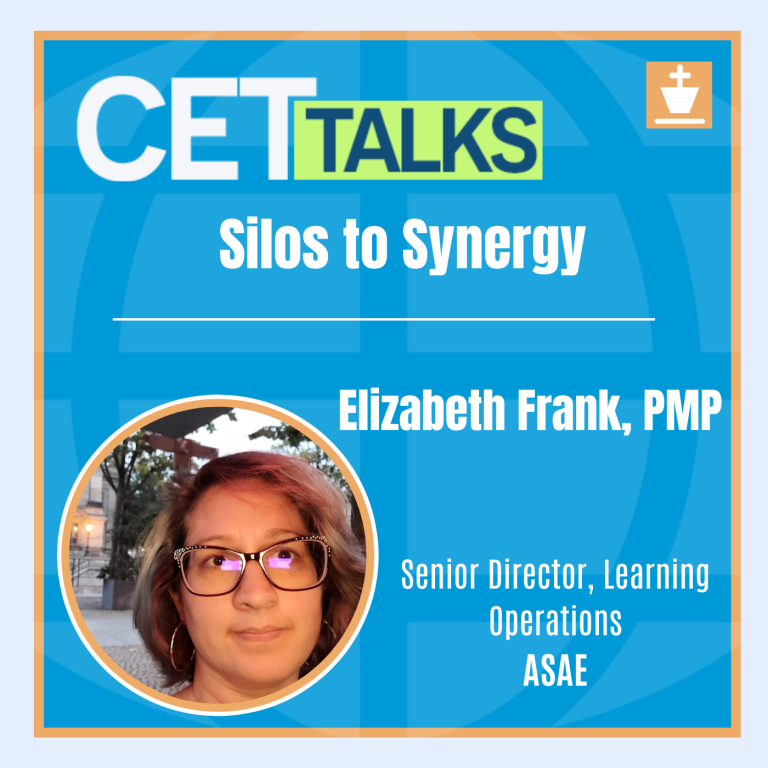
Episode 30: Silos to Synergy: Holistic Approaches to Creating Collaborative Learning

Episode 29: Credentials in Crisis: Challenges and Opportunities in Modern Education Recognition

Episode 28: Accreditation Uncovered: Essential Insights from an Industry Leader

Episode 27: Two Truths with a Lie: Managing the Myths of Modern-Day Learning

Episode 26: From Bending to Blending: Best Practices in Integrating Externally-Created Content
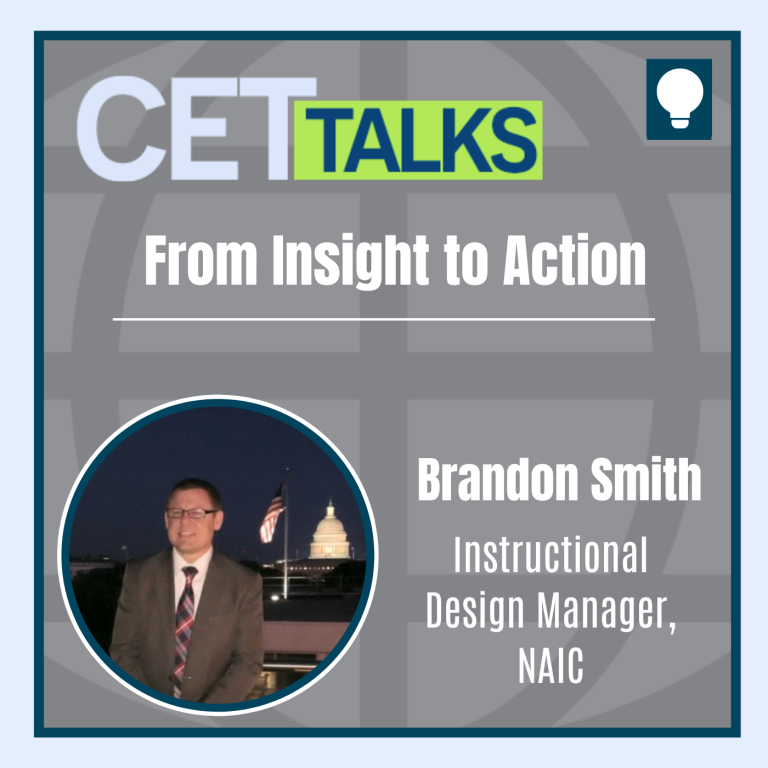
Episode 25: From Insight to Action: Charting the Career Path of a SME-turned-ISD

Episode 24: Cultivating Careers: The Power of Employee Engagement for Organizational Success

Episode 23: Igniting Imagination: Crafting Creativity in Training Environments

Episode 22: The Metrics of Change: Navigating Purposeful Measurement in L&D
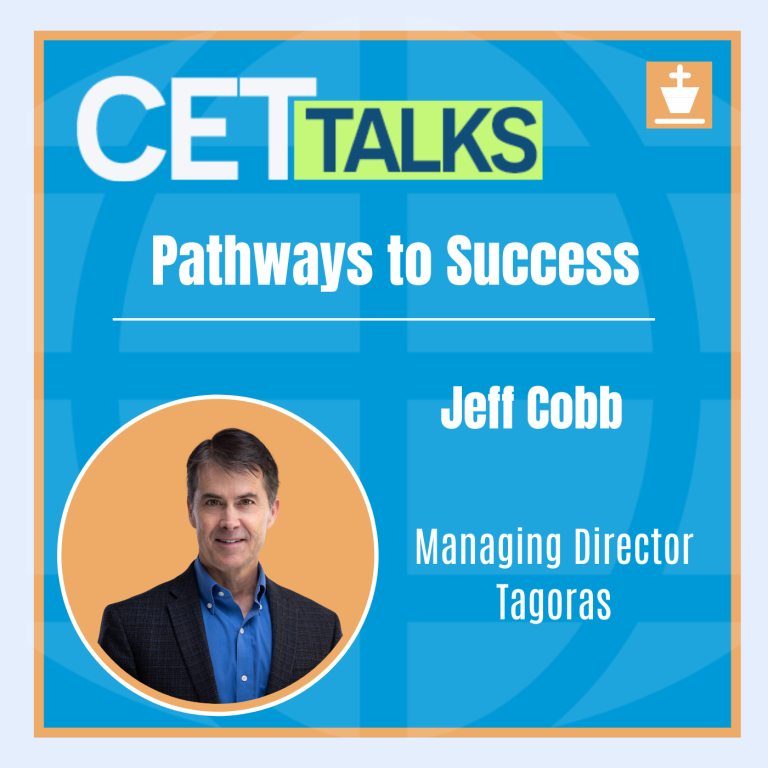
Episode 21: Pathways to Success: The Value of Lifelong Learning through Digital Credentials
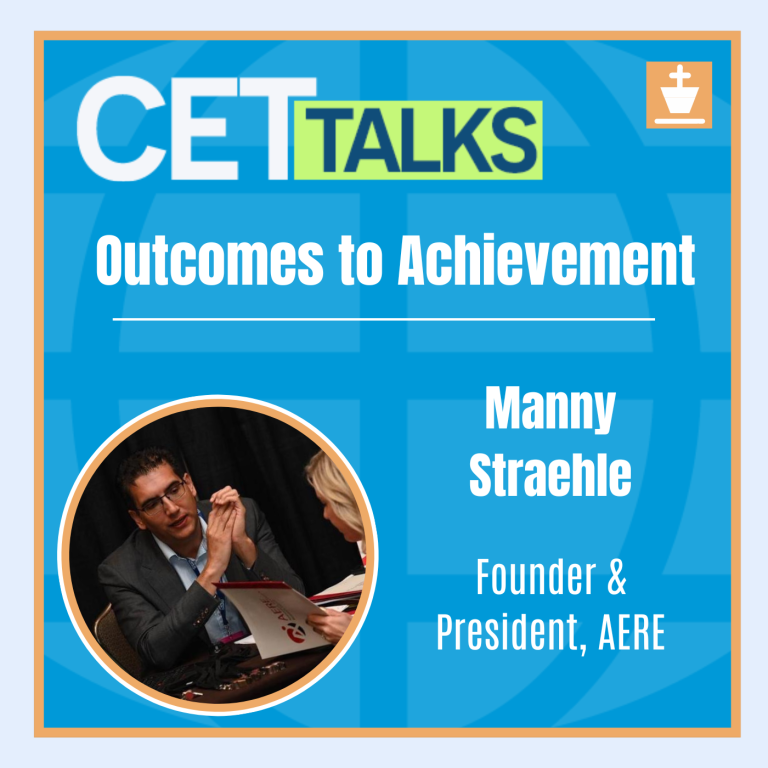
Episode 20: Outcomes to Achievement: Crafting Tomorrow’s Workforce Through Competency Models

Episode 19: Chatting with the Future: Enhancing AI Output Through Prompt Engineering

Episode 18: On the Inclusive Frontier: Harnessing Neurodivergence in Modern Training

Episode 17: Designing with Purpose: Strategies for Accessible e-Learning Development

Episode 16: Innovating Education: Navigating Accreditation for Short-Term Training
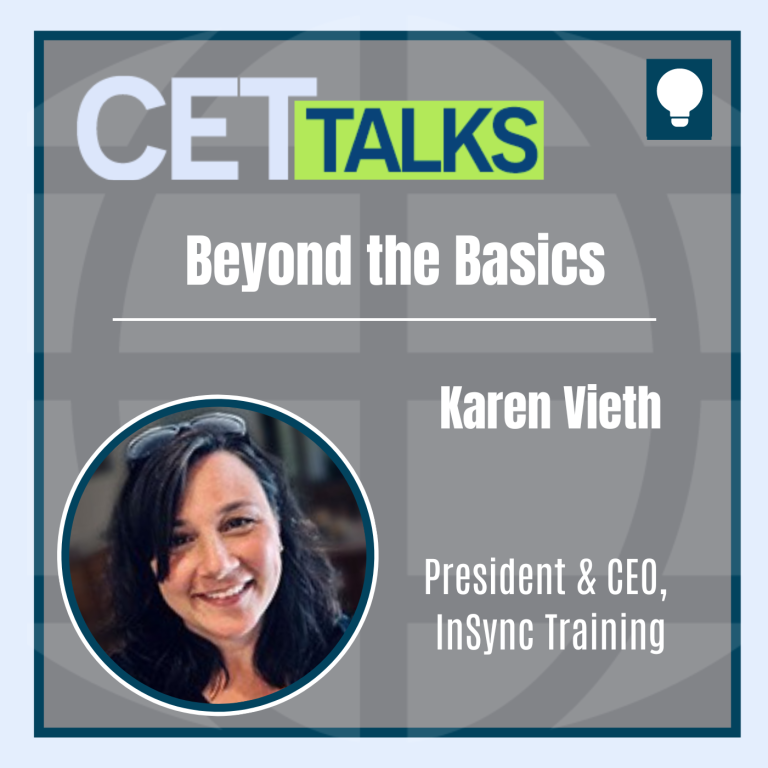
Episode 15: Beyond the Basics: Elevating Virtual Training through Expert Facilitation


